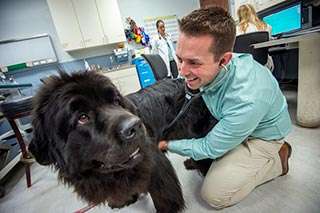Gene mutation for heart disease in Newfoundland dogs identified

Newfoundlands—those massive, furry, black dogs—have captured many a heart with their hallmark size, sweet nature and loyalty. Unfortunately these gentle giants' own hearts are all too often afflicted with a potentially lethal congenital disease called subvalvular aortic stenosis, or SAS, which also affects children and other dog breeds including the golden retriever.
A team of researchers led by UC Davis veterinary cardiologist Joshua Stern has for the first time identified a gene mutation responsible for canine SAS, the most common inherited heart disease in dogs. The study appears online in the journal Human Genetics.
"Our hope now is that breeders will be able to make informed breeding decisions and avoid breeding dogs that harbor this mutation, thus gradually eliminating the disease from the Newfoundland breed," Stern said. "In addition, now that we know one gene responsible for SAS and more about which proteins are involved, we can move forward to consider novel therapies that may help treat this devastating condition."
The researchers conducted a "whole genome" analysis, scanning thousands of genes, which revealed that the mutation associated with SAS resides in a gene called PICALM. This same gene mutation has been associated with the formation of plaque-like lesions in the brains of people with Alzheimer's disease, Stern said.
The researchers also conducted a pedigree analysis in a family of 45 Newfoundland dogs to examine the inheritance pattern of the SAS mutation. This analysis confirmed that the inheritance follows a certain pattern, by which only one parent needs to be carrying the gene mutation in order for the offspring to inherit the disease, and that not all dogs carrying the mutation will develop the disease.
SAS heart disease in dogs
SAS shows up in the dog's heart as abnormal tissue growth—often forming a ridge or ring below the aortic valve, which restricts blood flow from the heart into the aorta.
Diagnosing and treating SAS, however, is particularly challenging because the disease may appear in mild to severe forms. The first sign that a dog has SAS may be a collapse, fainting spell, irregular heart rate or even sudden death. Veterinarians may discover the disease when they detect a heart murmur and conduct further diagnostic tests such as chest X-rays, an echocardiogram or an electrocardiogram.
Dogs with the mild form of SAS may have a normal lifespan. Those with the severe form, however, are likely to die before they are 4 1/2 years old, even with therapeutic drugs.
SAS is rare in human children, but when it is diagnosed, surgical removal of the ridge or ring below the aortic valve is one option for improving the child's health. In dogs, however, such a surgical procedure has not increased survival, Stern said. Furthermore, he noted that open-heart surgery for dogs is only available at a few centers around the world.
The researchers are now beginning to study why SAS is less severe in some dogs while causing severe symptoms in others. They also are examining the genetic basis of SAS in the golden retriever, rottweiler and other dog breeds.
Testing for the gene mutation
Genetic tests for determining whether a dog carries the PICALM mutation are now available through North Carolina State University's College of Veterinary Medicine and will soon be available through the Veterinary Genetics Laboratory at the UC Davis School of Veterinary Medicine.
Stern and his colleagues began this study while at Ohio State University. Other researchers collaborating on the study were Stephen N. White of Washington State University; Linda B. Lehmkuhl of MedVet Medical and Cancer Centers for Pets; and Nanette M. Nascone-Yoder and Kathryn M. Meurs, both of North Carolina State University.
Funding for the study was provided through a Morris Animal Foundation—Pfizer Animal Health training grant and by the Newfoundland Club of America.
More information: "A single codon insertion in PICALM is associated with development of familial subvalvular aortic stenosis in Newfoundland dogs." Stern JA, et al. Hum Genet. 2014 Jun 5. [Epub ahead of print] www.ncbi.nlm.nih.gov/pubmed/24898977


















